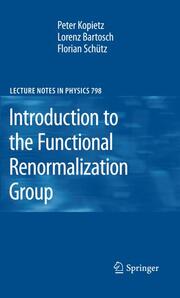Detailansicht
Introduction to the Functional Renormalization Group
Lecture Notes in Physics 798
ISBN/EAN: 9783642050930
Umbreit-Nr.: 1972613
Sprache:
Englisch
Umfang: xii, 380 S., 68 s/w Illustr., 380 p. 68 illus.
Format in cm:
Einband:
gebundenes Buch
Erschienen am 03.05.2010
Auflage: 1/2010
- Zusatztext
- The renormalization group (RG) has nowadays achieved the status of a meta-theory, which is a theory about theories. The theory of the RG consists of a set of concepts and methods which can be used to understand phenomena in many different ?elds of physics, ranging from quantum ?eld theory over classical statistical mechanics to nonequilibrium phenomena. RG methods are particularly useful to understand phenomena where ?uctuations involving many different length or time scales lead to the emergence of new collective behavior in complex many-body systems. In view of the diversity of ?elds where RG methods have been successfully applied, it is not surprising that a variety of apparently different implementations of the RG idea have been proposed. Unfortunately, this makes it somewhat dif?cult for beginners to learn this technique. For example, the ?eld-theoretical formulation of the RG idea looks at the ?rst sight rather different from the RG approach pioneered by Wilson, the latter being based on the concept of the effective action which is ite- tively calculated by successive elimination of the high-energy degrees of freedom. Moreover, the Wilsonian RG idea has been implemented in many different ways, depending on the particular problem at hand, and there seems to be no canonical way of setting up the RG procedure for a given problem.
- Kurztext
- This book, based on a graduate course given by the authors, is a pedagogic and self-contained introduction to the renormalization group with special emphasis on the functional renormalization group. The functional renormalization group is a modern formulation of the Wilsonian renormalization group in terms of formally exact functional differential equations for generating functionals. In Part I the reader is introduced to the basic concepts of the renormalization group idea, requiring only basic knowledge of equilibrium statistical mechanics. More advanced methods, such as diagrammatic perturbation theory, are introduced step by step. Part II then gives a self-contained introduction to the functional renormalization group. After a careful definition of various types of generating functionals, the renormalization group flow equations for these functionals are derived. This procedure is shown to encompass the traditional method of the mode elimination steps of the Wilsonian renormalization group procedure. Then, approximate solutions of these flow equations using expansions in powers of irreducible vertices or in powers of derivatives are given. Finally, in Part III the exact hierarchy of functional renormalization group flow equations for the irreducible vertices is used to study various aspects of non-relativistic fermions, including the so-called BCS-BEC crossover, thereby making the link to contemporary research topics.
